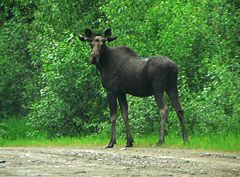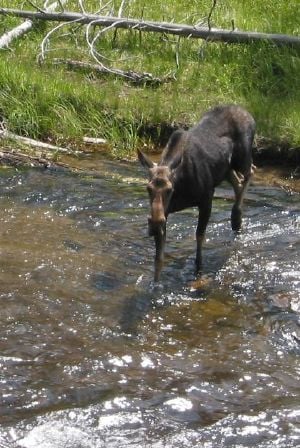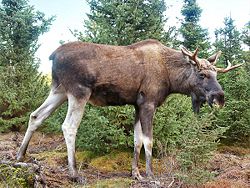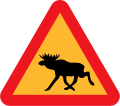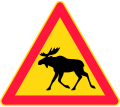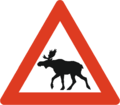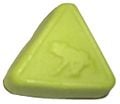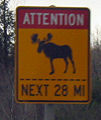Difference between revisions of "Moose" - New World Encyclopedia
Rosie Tanabe (talk | contribs) |
|||
| (34 intermediate revisions by 6 users not shown) | |||
| Line 1: | Line 1: | ||
| − | {{ | + | {{Copyedited}}{{Approved}}{{Images OK}}{{Submitted}}{{Paid}} |
{{Taxobox | {{Taxobox | ||
| color = pink | | color = pink | ||
| Line 13: | Line 13: | ||
| subfamilia = [[Odocoilinae]] | | subfamilia = [[Odocoilinae]] | ||
| genus = '''''Alces''''' | | genus = '''''Alces''''' | ||
| − | | genus_authority = [[John Edward Gray|Gray]], | + | | genus_authority = [[John Edward Gray|Gray]], 1821 |
| species = '''''A. alces''''' | | species = '''''A. alces''''' | ||
| binomial = ''Alces alces'' | | binomial = ''Alces alces'' | ||
| − | | binomial_authority = ([[Carolus Linnaeus|Linnaeus]], | + | | binomial_authority = ([[Carolus Linnaeus|Linnaeus]], 1758) |
| range_map = Moose distribution.png | | range_map = Moose distribution.png | ||
| range_map_width = 250px | | range_map_width = 250px | ||
| range_map_caption = Moose range map | | range_map_caption = Moose range map | ||
}} | }} | ||
| + | The '''moose''' (plural "moose") is the largest extant [[species]] ''(Alces alces)'' of [[deer]] (family [[Cervidae]]) in the world. It is distinguished from the others by the palmate [[antler]]s of its males. While ''Alces alces'' is called moose in [[North America]], derived from [[Eastern Abenaki language|Eastern Abenaki]] ''moz''), this species is called ''elk'' in [[Anglophone]] [[Europe]]. In North America, the term [[elk]] (also wapiti) refers to the deer species ''Cervus canadensis''. The moose can live approximately 20 years or more in the wild (SNP 2007). | ||
| + | {{toc}} | ||
| + | Moose add to the wonder of nature for humans, with these giant animals even being observed swimming and diving underwater for up to a minute to get [[plant]]s to eat. | ||
| − | |||
==Habitat and range== | ==Habitat and range== | ||
| − | Moose are typical of [[boreal forest|boreal]] and [[Temperate broadleaf and mixed forests|mixed deciduous forests]] of the [[Northern Hemisphere]] in [[temperate]] to [[Subarctic climate|subarctic]] climates. In [[North America]], that includes almost all of [[Canada]], [[Alaska]], much of [[New England]], and the upper [[Rocky Mountains]]. | + | Moose are typical of [[boreal forest|boreal]] and [[Temperate broadleaf and mixed forests|mixed deciduous forests]] of the [[Northern Hemisphere]] in [[temperate]] to [[Subarctic climate|subarctic]] climates. In [[North America]], that includes almost all of [[Canada]], [[Alaska]], much of [[New England]], and the upper [[Rocky Mountains]]. They can often be found feeding by margins of ponds, lakes and rivers, swamps, bogs, tundra, and fresh water (SNP 2007). |
| − | Moose have been successfully introduced on the island of [[Newfoundland]] in 1904 where they are now the dominant [[ungulate]], and somewhat less successfully on [[Anticosti Island]] in the [[Gulf of St. Lawrence]]. Ten moose were also introduced in [[Fiordland]], [[New Zealand]] in 1910, but | + | |
| + | Moose have been successfully introduced on the island of [[Newfoundland]] in 1904, where they are now the dominant [[ungulate]], and somewhat less successfully on [[Anticosti Island]] in the [[Gulf of St. Lawrence]]. Ten moose were also introduced in [[Fiordland]], [[New Zealand]] in 1910, but have been believed to have died off. Nevertheless, there have been reported sightings that were thought to be false until moose hair samples were found by a New Zealand scientist in 2002 (Oldham 2005). | ||
==Physical characteristics== | ==Physical characteristics== | ||
| + | The great length of the legs gives the moose a decidedly lanky appearance. The muzzle is long and fleshy, with only a very small triangular naked patch below the nostrils. Males have a peculiar sac, known as a bell, hanging from the neck. The usual stride of a moose is a shambling trot but, when pressed, they can break into a gallop and reach speeds of up to 55 kilometers per hour (34 miles per hour). | ||
| + | |||
| + | Male moose (bulls) normally weigh 540 to 720 kg (1200–1600 lbs) and females (cows) usually about 400 kg (880 lb). The typical height is about 1.9 meters (6.2 feet) at the shoulder. Calves weigh around 15 kg (33 lb) at birth but quickly grow in size. | ||
| + | |||
===Antlers=== | ===Antlers=== | ||
| + | Only males have antlers, often 160 cm (64 inches) across and 20 kg (44 lb) in weight with a broad, flattened palmate shape fringed in up to 30 tines. An Alaskan moose discovered in 1897 holds the record for the largest known modern deer; it was a male standing 2.34 m (7.7 feet) at the shoulders and weighing 825 kg (1815 lb). Its antler spread was 199 cm (79 inches). | ||
| + | |||
The male moose's antlers arise as cylindrical beams projecting on each side at right angles to the middle line of the skull, which after a short distance divide in a fork-like manner. The lower prong of this fork may be either simple, or divided into two or three tines, with some flattening. | The male moose's antlers arise as cylindrical beams projecting on each side at right angles to the middle line of the skull, which after a short distance divide in a fork-like manner. The lower prong of this fork may be either simple, or divided into two or three tines, with some flattening. | ||
| − | [[Image:Moose standing.jpg|thumb|right|A full grown bull moose from [[British Columbia]] with early (May) antlers]] | + | [[Image:Moose standing.jpg|thumb|right|240px|A full grown bull moose from [[British Columbia]] with early (May) antlers.]] |
| − | In the North [[Siberia]]n | + | In the North [[Siberia]]n subspecies of the moose ''(Alces alces bedfordiae)'', the posterior division of the main fork divides into three tines, with no distinct flattening. In the common moose ''(Alces alces alces)'', on the other hand, this branch usually expands into a broad palmation, with one large tine at the base, and a number of smaller snags on the free border. |
| − | There is | + | There is a [[Scandinavia]]n breed of the common moose in which the antlers are simpler and recall those of the East Siberian race. |
| − | The palmation appears to be more marked in the North American | + | The palmation appears to be more marked in the North American subspecies ''(Alces alces americanus)'' than in the typical Scandinavian subspecies. The largest of all is the Alaskan race ''(Alces alces gigas)'', which can stand over two m (6.5 ft) in height, with a span across the antlers of 1.8 m (6 ft). |
| − | The male moose will drop its antlers after mating season in order to conserve energy for the winter season. It will then regrow them in the spring. The antlers take about three to five months to grow. This makes their antlers one of the fastest growing organs in the world. The antlers initially have a layer of skin, which will shed off once fully grown. | + | The male moose will drop its antlers after mating season in order to conserve energy for the winter season. It will then regrow them in the spring. The antlers take about three to five months to grow. This makes their antlers one of the fastest growing [[organ (anatomy)|organs]] in the world. The antlers initially have a layer of [[skin]], which will shed off once fully grown. |
| − | If a bull moose is ever castrated | + | If a bull moose is ever castrated, either due to accidental or chemical means, he will quickly shed his current set of antlers and then immediately begin to grow a new set of misshapen and deformed antlers that he will wear the rest of his life without ever shedding again. The distinctive looking appendages, often referred to as "devil's antlers," are the source of several myths and legends among many groups of [[Inuit]] as well as several other tribes of indigenous peoples of North America. |
[[Image:Moose crossing river in yellowstone.jpg|thumb|left|A moose crossing a river.]] | [[Image:Moose crossing river in yellowstone.jpg|thumb|left|A moose crossing a river.]] | ||
| − | === | + | ==Lifestyle== |
| − | + | ===Diet=== | |
| + | Moose eat mostly young shoots and [[leaf|leaves]] of [[willow]] and [[birch]], tree [[bark]], water plants (such as ''Arnicus brucitus''), and during winter, mast, which are fallen [[Nut (fruit)|nuts]] of forest trees. These [[ruminant]]s are often found feeding in [[wetland]]s and [[swamp]]s. Moose are extremely strong swimmers and are known to dive underwater in lakes and ponds in order to pull up plants from the bottom. They are able to stay under water for a full minute before coming up for air. | ||
| − | + | Their [[teeth]] resemble those of other ruminants such as [[cattle]], [[sheep]], [[goat]]s and other [[deer]]. On each side of the lower jaw they have three [[molar]]s, three [[premolar]]s, and four front teeth, one of which is a transformed [[canine tooth|canine]]. In the upper jaw there are no front teeth, only a plate of horn against which the food is chewed. | |
| − | + | During the winter, moose feed on approximately 18 to 22 kg (40 to 50 lb) of twigs and [[shrub]]s a day, while consuming approximately 22 to 27 kg (50 to 60 lb) of various types of leaves, shrubs, and water plants a day during the summer (SNP 2007). | |
| − | |||
| − | + | ===Breeding=== | |
| + | During the mating season, which lasts from mid September to mid-October, females call to males, bolstering their efforts by emitting a scent that attracts the opposite sex. They congregate and males then compete for their attention, warding off competitors with threatening displays of their antlers, sometimes engaging in pushing fights that rarely develop into serious fights because of the deadly consequence of locking antlers (NW 2007). During this time, bulls also splash [[urine]]-soaked mud onto their bells in order to attract females. | ||
| − | + | Gestation usually takes eight to nine months and a calf is usually born in the spring or early summer (BBC UK 2007). Within a day, a calf can walk and within a couple weeks a calf can swim. Calves are weaned after about six months and stay with their mother until her next young are born. Mothers, being very protective of their young, have been known to charge if people get too close. Similarly, during mating season, bull moose also may charge people and even cars (NW 2007). Although male bulls tend to take more than one mate, during the mating season the bull will usually stay with a given cow for most of the season (SNP 2007). | |
| − | + | ===Predators=== | |
| + | The primary predators of moose are black and grizzly [[bear]]s and [[wolf|wolves]], but [[cougar]]s and [[wolverine]]s have been known to hunt them as well. During the winter, wolves have an easier time preying on moose as the snow is deep and ponds and lakes freeze over, making it is easy for moose to slip and fall. In Newfoundland, about 22,000 moose are harvested yearly as game (SNP 2007). | ||
| − | + | ==History== | |
| + | European rock drawings and [[cave painting]]s reveal that the moose has been hunted since the [[stone age]]. Excavations in Alby, Sweden, adjacent to the Stora Alvaret, have yielded antlers in wooden hut remains from 6000 B.C.E..E., indicating some of the earliest moose hunting in northern Europe. | ||
| − | + | In Northern Scandinavia, one can still find remains of [[trapping pit]]s used for hunting moose. These pits, which can be up four by seven meters wide and two meters deep, would have been camouflaged with branches and [[leaf|leaves]]. They would have had steep sides lined with planks, making it impossible for the moose to escape once it fell in. The pits are normally found in large groups, crossing the moose's regular paths and stretching over several kilometers. Remains of wooden fences designed to guide the animals toward the pits have been found in bogs and peats. In Norway, an early example of these trapping devices has been dated to around 3700 B.C.E. Trapping moose in pits is an extremely effective hunting method, and as early as the sixteenth century the Norwegian government tried to restrict their use. Nevertheless, the method was in use until the nineteenth century. | |
| − | + | The first written description of the moose hunt is in [[Julius Caesar|Julius Cæsar's]] ''Commentarii de Bello Gallico'', where it is described thus: | |
| − | + | :''"There are also animals which are called alces. The shape of these, and the varied color of their skins, is much like roes, but in size they surpass them a little and are without horns, and have legs without joints and ligatures; nor do they lie down for the purpose of rest, nor, if they have been thrown down by any accident, can they raise or lift themselves up. Trees serve as beds to them; they lean themselves against them, and thus reclining only slightly, they take their rest; when the huntsmen have discovered from the footsteps of these animals whither they are accustomed to betake themselves, they either undermine all the trees at the roots, or cut into them so far that the upper part of the trees may appear to be left standing. When they have leant upon them, according to their habit, they knock down by their weight the unsupported trees, and fall down themselves along with them."'' | |
| − | |||
| − | + | In chapter 16 of [[Pliny the Elder]]'s [[Natural History]] from 77 C.E. the moose (called here elk) and an animal called achlis, which is presumably the same animal, are described thus: | |
| − | |||
| − | |||
| − | |||
| − | |||
| − | |||
| − | |||
| − | + | :''"...there is, also, the elk, which strongly resembles our steers, except that it is distinguished by the length of the ears and of the neck. There is also the achlis, which is produced in the island of Scandinavia; it has never been seen in this city, although we have had descriptions of it from many persons; it is not unlike the elk, but has no joints in the hind leg. Hence, it never lies down, but reclines against a tree while it sleeps; it can only be taken by previously cutting into the tree, and thus laying a trap for it, as otherwise, it would escape through its swiftness. Its upper lip is so extremely large, for which reason it is obliged to go backwards when grazing; otherwise, by moving onwards, the lip would get doubled up."'' | |
| − | + | Dr. Valerius Geist, who emigrated to [[Canada]] from the [[Soviet Union]] wrote in his book ''Moose: Behavior, Ecology, Conservation'' (1999): | |
| − | + | :''"Those who care most passionately about moose are—paradoxically—[[hunter]]s, in particular people who live in wilderness and rural communities and those who depend on moose for food. In [[Sweden]], no fall menu is without a mouthwatering moose dish. The Swedes fence their highways to reduce moose fatalities and design moose-proof cars. Sweden is less than half as large as the Canadian province of [[British Columbia]], but the annual take of moose in Sweden—upward of 150,000—is twice that of the total moose harvest in [[North America]]. That is how much Swedes cherish their moose."'' | |
| − | + | ==Domestication== | |
| − | + | Domestication of moose was investigated in the [[Soviet Union]] before [[World War II]]. Early experiments were inconclusive, but with the creation of a moose farm at [[Pechora-Ilych Nature Reserve]] in 1949, a small-scale moose domestication program was started, involving attempts at [[selective breeding]] of animals based on their behavioral characteristics. Since 1963, the program has continued at [[Kostroma Moose Farm]], which had a herd of 33 [[tame]] moose as of 2003. Although at this stage the farm is not expected to be a profit-making enterprise, it obtains some income from the sale of moose [[milk]] and from visiting tour groups. Its main value, however, is seen in the opportunities it offers for the research in the [[physiology]] and behavior of the moose, as well as in the insights it provides into the general principles of animal [[domestication]]. | |
| − | |||
| − | |||
| − | |||
| − | |||
| − | |||
| − | |||
| − | |||
==Vehicle collisions and moose warning signs== | ==Vehicle collisions and moose warning signs== | ||
[[Image:Moose-Gustav.jpg|left|thumb|250 px|Young moose in Grönåsens Moosepark, Sweden]] | [[Image:Moose-Gustav.jpg|left|thumb|250 px|Young moose in Grönåsens Moosepark, Sweden]] | ||
| − | A moose's body structure, with a large heavy body suspended on long spindly legs, makes these animals particularly dangerous when hit by motor vehicles. Such collisions are often fatal for both the moose and motorist. This has led to the development of a vehicle test in Scandinavia referred to as the " | + | A moose's body structure, with a large heavy body suspended on long spindly legs, makes these animals particularly dangerous when hit by motor vehicles. Such collisions are often fatal for both the moose and motorist. This has led to the development of a vehicle test in Scandinavia referred to as the "moose test" ''(Älgtest)''. In an advertising campaign, the [[Sweden|Swedish]] car manufacturers [[Volvo]] and [[Saab Automobile|Saab]] warned people of buying Japanese cars by stating "There are no moose in Japan." |
| − | Generally, upon impact the bumper of the car will break the moose's legs. The main body of the moose will then collide with the windshield, often with disastrous effect to both motorist and animal. In a collision of this nature, a car's [[airbag]]s may not deploy or be of much use if they do | + | |
| + | Generally, upon impact the bumper of the car will break the moose's legs. The main body of the moose will then collide with the windshield, often with disastrous effect to both motorist and animal. In a collision of this nature, a car's [[airbag]]s may not deploy or be of much use if they do (SNRTRI 2004). | ||
| − | Moose warning signs are used on roads in regions where there is a danger of collision with the animal. The triangular warning signs common in Sweden and Norway have become coveted souvenirs among the many German tourists traveling in these countries, and authorities have had to issue warnings that it is a dangerous and criminal practice to remove one of these signs. The popularity of these signs has led to them being depicted on all kinds of souvenirs, such as coffee mugs, neckties or T-shirts, and full-size copies of the actual signs may be bought. In the mid 1990s, the Swedish postal service issued a triangular stamp with a moose warning sign, intended to cater especially to German tourists writing postcards home. The [[brand]] ''[[Ahlgrens|Ahlgrens bilar]]'' ("Ahlgren's Cars"), a popular confectionery product | + | Moose warning signs are used on roads in regions where there is a danger of collision with the animal. The triangular warning signs common in Sweden and Norway have become coveted souvenirs among the many German tourists traveling in these countries, and authorities have had to issue warnings that it is a dangerous and criminal practice to remove one of these signs. The popularity of these signs has led to them being depicted on all kinds of souvenirs, such as coffee mugs, neckties or T-shirts, and full-size copies of the actual signs may be bought. In the mid 1990s, the Swedish postal service issued a triangular stamp with a moose warning sign, intended to cater especially to German tourists writing postcards home. The [[brand]] ''[[Ahlgrens|Ahlgrens bilar]]'' ("Ahlgren's Cars"), a popular confectionery product that has been on the market since 1953, has in recent years been extended to other car- and road-related products, one of which, depicting Swedish road signs, includes a candy moose warning sign. |
| − | In the [[Canada|Canadian]] province of [[New Brunswick]], collisions with moose are frequent enough that all new highways have fences to prevent moose from accessing the road. | + | In the [[Canada|Canadian]] province of [[New Brunswick]], collisions with moose are frequent enough that all new highways have fences to prevent moose from accessing the road. Demonstratively, Highway 7 between [[Fredericton]] and [[Saint John, New Brunswick|Saint John]], which has one of the highest incidences of moose collisions in the province, does not have these fences, although it is extremely well signed (DT 2007). |
<gallery> | <gallery> | ||
| Line 113: | Line 112: | ||
</gallery> | </gallery> | ||
| − | |||
| − | |||
| − | |||
| − | |||
| − | |||
| − | |||
==References== | ==References== | ||
| − | |||
| − | *Flexner, | + | *BBC UK. 2007. Science and nature: animals. Moose, elk ''British Broadcasting Company, United Kingdom''. |
| − | + | *Department of Transporation (DT), New Brunswick, Canada. 2007. [http://www.gnb.ca/0113/moose/alert-e.asp Danger...moose: protect yourself and protect your family from moose-vehicle collisions] ''New Brunswick Department of Transportation''. Retrieved March 8, 2008. | |
| − | * | + | *Flexner, S. B. 1987. ''The Random House Dictionary of the English Language''. New York: Random House. ISBN 0394500504 |
| − | + | * IUCN Red List of Threatened Species (IUCNTS). 2007. [http://www.iucnredlist.org/search/details.php/41782/all ''Alces alces''] ''Species Information''. Retrieved March 8, 2008. | |
| − | + | *Landskrona Slott (LS). 2007. [http://www.nada.kth.se/~fred/tycho/nose.html#moose Tycho Brahe's nose and the story of his pet moose] ''Landskrona Slott''. Retrieved March 8, 2008. | |
| − | + | * Moose in the City (MC). 2007. [http://www.toronto.ca/moose/home.htm Moose in the city] ''Out of the blue''. Retrieved March 8, 2008. | |
| − | + | *Nature Works (NW). 2007. [http://www.nhptv.org/NatureWorks/moose.htm Moose, ''Alces alces''] ''Nature Works''. Retrieved March 8, 2008. | |
| − | *[http://www. | + | * Oldham, S. 2005. [http://www.nzherald.co.nz/location/story.cfm?l_id=141&ObjectID=10348890 Hairs move New Zealand Moose out of Realm of Nessie] ''New Zealand Herald''. October 6, 2005. Retrieved March 8, 2008. |
| − | * | + | *Salmonier Nature Park (SNP). 2007. [http://www.env.gov.nl.ca/snp/Animals/moose.htm Various information on moose, ''Alces alces''] ''Salmonier Nature Park''. Retrieved March 8, 2008. |
| − | + | * Swedish National Road and Transport Research Institute (SNRTRI). 2004. Nordic road & transport research: Evaluation of the moose dummy mooses II with a view to consumer guidance'' ''Swedish National Road and Transport Research Institute''. | |
| − | * | ||
| − | |||
| − | *[http://www. | ||
| − | |||
| − | *[http://www.env.gov.nl.ca/ | ||
| − | |||
| − | |||
| − | |||
| − | |||
| + | {{credit|146803233}} | ||
[[Category:Life sciences]] | [[Category:Life sciences]] | ||
| − | + | [[Category:Animals]] | |
| + | [[Category:Mammals]][[Category:Ungulates]] | ||
Latest revision as of 13:14, 10 March 2023
| Moose | ||||||||||||||||
|---|---|---|---|---|---|---|---|---|---|---|---|---|---|---|---|---|
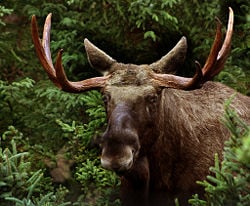 | ||||||||||||||||
| Scientific classification | ||||||||||||||||
| ||||||||||||||||
| Alces alces (Linnaeus, 1758) | ||||||||||||||||
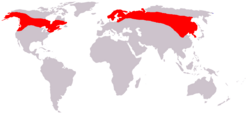 Moose range map
|
The moose (plural "moose") is the largest extant species (Alces alces) of deer (family Cervidae) in the world. It is distinguished from the others by the palmate antlers of its males. While Alces alces is called moose in North America, derived from Eastern Abenaki moz), this species is called elk in Anglophone Europe. In North America, the term elk (also wapiti) refers to the deer species Cervus canadensis. The moose can live approximately 20 years or more in the wild (SNP 2007).
Moose add to the wonder of nature for humans, with these giant animals even being observed swimming and diving underwater for up to a minute to get plants to eat.
Habitat and range
Moose are typical of boreal and mixed deciduous forests of the Northern Hemisphere in temperate to subarctic climates. In North America, that includes almost all of Canada, Alaska, much of New England, and the upper Rocky Mountains. They can often be found feeding by margins of ponds, lakes and rivers, swamps, bogs, tundra, and fresh water (SNP 2007).
Moose have been successfully introduced on the island of Newfoundland in 1904, where they are now the dominant ungulate, and somewhat less successfully on Anticosti Island in the Gulf of St. Lawrence. Ten moose were also introduced in Fiordland, New Zealand in 1910, but have been believed to have died off. Nevertheless, there have been reported sightings that were thought to be false until moose hair samples were found by a New Zealand scientist in 2002 (Oldham 2005).
Physical characteristics
The great length of the legs gives the moose a decidedly lanky appearance. The muzzle is long and fleshy, with only a very small triangular naked patch below the nostrils. Males have a peculiar sac, known as a bell, hanging from the neck. The usual stride of a moose is a shambling trot but, when pressed, they can break into a gallop and reach speeds of up to 55 kilometers per hour (34 miles per hour).
Male moose (bulls) normally weigh 540 to 720 kg (1200–1600 lbs) and females (cows) usually about 400 kg (880 lb). The typical height is about 1.9 meters (6.2 feet) at the shoulder. Calves weigh around 15 kg (33 lb) at birth but quickly grow in size.
Antlers
Only males have antlers, often 160 cm (64 inches) across and 20 kg (44 lb) in weight with a broad, flattened palmate shape fringed in up to 30 tines. An Alaskan moose discovered in 1897 holds the record for the largest known modern deer; it was a male standing 2.34 m (7.7 feet) at the shoulders and weighing 825 kg (1815 lb). Its antler spread was 199 cm (79 inches).
The male moose's antlers arise as cylindrical beams projecting on each side at right angles to the middle line of the skull, which after a short distance divide in a fork-like manner. The lower prong of this fork may be either simple, or divided into two or three tines, with some flattening.
In the North Siberian subspecies of the moose (Alces alces bedfordiae), the posterior division of the main fork divides into three tines, with no distinct flattening. In the common moose (Alces alces alces), on the other hand, this branch usually expands into a broad palmation, with one large tine at the base, and a number of smaller snags on the free border.
There is a Scandinavian breed of the common moose in which the antlers are simpler and recall those of the East Siberian race.
The palmation appears to be more marked in the North American subspecies (Alces alces americanus) than in the typical Scandinavian subspecies. The largest of all is the Alaskan race (Alces alces gigas), which can stand over two m (6.5 ft) in height, with a span across the antlers of 1.8 m (6 ft).
The male moose will drop its antlers after mating season in order to conserve energy for the winter season. It will then regrow them in the spring. The antlers take about three to five months to grow. This makes their antlers one of the fastest growing organs in the world. The antlers initially have a layer of skin, which will shed off once fully grown.
If a bull moose is ever castrated, either due to accidental or chemical means, he will quickly shed his current set of antlers and then immediately begin to grow a new set of misshapen and deformed antlers that he will wear the rest of his life without ever shedding again. The distinctive looking appendages, often referred to as "devil's antlers," are the source of several myths and legends among many groups of Inuit as well as several other tribes of indigenous peoples of North America.
Lifestyle
Diet
Moose eat mostly young shoots and leaves of willow and birch, tree bark, water plants (such as Arnicus brucitus), and during winter, mast, which are fallen nuts of forest trees. These ruminants are often found feeding in wetlands and swamps. Moose are extremely strong swimmers and are known to dive underwater in lakes and ponds in order to pull up plants from the bottom. They are able to stay under water for a full minute before coming up for air.
Their teeth resemble those of other ruminants such as cattle, sheep, goats and other deer. On each side of the lower jaw they have three molars, three premolars, and four front teeth, one of which is a transformed canine. In the upper jaw there are no front teeth, only a plate of horn against which the food is chewed.
During the winter, moose feed on approximately 18 to 22 kg (40 to 50 lb) of twigs and shrubs a day, while consuming approximately 22 to 27 kg (50 to 60 lb) of various types of leaves, shrubs, and water plants a day during the summer (SNP 2007).
Breeding
During the mating season, which lasts from mid September to mid-October, females call to males, bolstering their efforts by emitting a scent that attracts the opposite sex. They congregate and males then compete for their attention, warding off competitors with threatening displays of their antlers, sometimes engaging in pushing fights that rarely develop into serious fights because of the deadly consequence of locking antlers (NW 2007). During this time, bulls also splash urine-soaked mud onto their bells in order to attract females.
Gestation usually takes eight to nine months and a calf is usually born in the spring or early summer (BBC UK 2007). Within a day, a calf can walk and within a couple weeks a calf can swim. Calves are weaned after about six months and stay with their mother until her next young are born. Mothers, being very protective of their young, have been known to charge if people get too close. Similarly, during mating season, bull moose also may charge people and even cars (NW 2007). Although male bulls tend to take more than one mate, during the mating season the bull will usually stay with a given cow for most of the season (SNP 2007).
Predators
The primary predators of moose are black and grizzly bears and wolves, but cougars and wolverines have been known to hunt them as well. During the winter, wolves have an easier time preying on moose as the snow is deep and ponds and lakes freeze over, making it is easy for moose to slip and fall. In Newfoundland, about 22,000 moose are harvested yearly as game (SNP 2007).
History
European rock drawings and cave paintings reveal that the moose has been hunted since the stone age. Excavations in Alby, Sweden, adjacent to the Stora Alvaret, have yielded antlers in wooden hut remains from 6000 B.C.E., indicating some of the earliest moose hunting in northern Europe.
In Northern Scandinavia, one can still find remains of trapping pits used for hunting moose. These pits, which can be up four by seven meters wide and two meters deep, would have been camouflaged with branches and leaves. They would have had steep sides lined with planks, making it impossible for the moose to escape once it fell in. The pits are normally found in large groups, crossing the moose's regular paths and stretching over several kilometers. Remains of wooden fences designed to guide the animals toward the pits have been found in bogs and peats. In Norway, an early example of these trapping devices has been dated to around 3700 B.C.E. Trapping moose in pits is an extremely effective hunting method, and as early as the sixteenth century the Norwegian government tried to restrict their use. Nevertheless, the method was in use until the nineteenth century.
The first written description of the moose hunt is in Julius Cæsar's Commentarii de Bello Gallico, where it is described thus:
- "There are also animals which are called alces. The shape of these, and the varied color of their skins, is much like roes, but in size they surpass them a little and are without horns, and have legs without joints and ligatures; nor do they lie down for the purpose of rest, nor, if they have been thrown down by any accident, can they raise or lift themselves up. Trees serve as beds to them; they lean themselves against them, and thus reclining only slightly, they take their rest; when the huntsmen have discovered from the footsteps of these animals whither they are accustomed to betake themselves, they either undermine all the trees at the roots, or cut into them so far that the upper part of the trees may appear to be left standing. When they have leant upon them, according to their habit, they knock down by their weight the unsupported trees, and fall down themselves along with them."
In chapter 16 of Pliny the Elder's Natural History from 77 C.E. the moose (called here elk) and an animal called achlis, which is presumably the same animal, are described thus:
- "...there is, also, the elk, which strongly resembles our steers, except that it is distinguished by the length of the ears and of the neck. There is also the achlis, which is produced in the island of Scandinavia; it has never been seen in this city, although we have had descriptions of it from many persons; it is not unlike the elk, but has no joints in the hind leg. Hence, it never lies down, but reclines against a tree while it sleeps; it can only be taken by previously cutting into the tree, and thus laying a trap for it, as otherwise, it would escape through its swiftness. Its upper lip is so extremely large, for which reason it is obliged to go backwards when grazing; otherwise, by moving onwards, the lip would get doubled up."
Dr. Valerius Geist, who emigrated to Canada from the Soviet Union wrote in his book Moose: Behavior, Ecology, Conservation (1999):
- "Those who care most passionately about moose are—paradoxically—hunters, in particular people who live in wilderness and rural communities and those who depend on moose for food. In Sweden, no fall menu is without a mouthwatering moose dish. The Swedes fence their highways to reduce moose fatalities and design moose-proof cars. Sweden is less than half as large as the Canadian province of British Columbia, but the annual take of moose in Sweden—upward of 150,000—is twice that of the total moose harvest in North America. That is how much Swedes cherish their moose."
Domestication
Domestication of moose was investigated in the Soviet Union before World War II. Early experiments were inconclusive, but with the creation of a moose farm at Pechora-Ilych Nature Reserve in 1949, a small-scale moose domestication program was started, involving attempts at selective breeding of animals based on their behavioral characteristics. Since 1963, the program has continued at Kostroma Moose Farm, which had a herd of 33 tame moose as of 2003. Although at this stage the farm is not expected to be a profit-making enterprise, it obtains some income from the sale of moose milk and from visiting tour groups. Its main value, however, is seen in the opportunities it offers for the research in the physiology and behavior of the moose, as well as in the insights it provides into the general principles of animal domestication.
Vehicle collisions and moose warning signs
A moose's body structure, with a large heavy body suspended on long spindly legs, makes these animals particularly dangerous when hit by motor vehicles. Such collisions are often fatal for both the moose and motorist. This has led to the development of a vehicle test in Scandinavia referred to as the "moose test" (Älgtest). In an advertising campaign, the Swedish car manufacturers Volvo and Saab warned people of buying Japanese cars by stating "There are no moose in Japan."
Generally, upon impact the bumper of the car will break the moose's legs. The main body of the moose will then collide with the windshield, often with disastrous effect to both motorist and animal. In a collision of this nature, a car's airbags may not deploy or be of much use if they do (SNRTRI 2004).
Moose warning signs are used on roads in regions where there is a danger of collision with the animal. The triangular warning signs common in Sweden and Norway have become coveted souvenirs among the many German tourists traveling in these countries, and authorities have had to issue warnings that it is a dangerous and criminal practice to remove one of these signs. The popularity of these signs has led to them being depicted on all kinds of souvenirs, such as coffee mugs, neckties or T-shirts, and full-size copies of the actual signs may be bought. In the mid 1990s, the Swedish postal service issued a triangular stamp with a moose warning sign, intended to cater especially to German tourists writing postcards home. The brand Ahlgrens bilar ("Ahlgren's Cars"), a popular confectionery product that has been on the market since 1953, has in recent years been extended to other car- and road-related products, one of which, depicting Swedish road signs, includes a candy moose warning sign.
In the Canadian province of New Brunswick, collisions with moose are frequent enough that all new highways have fences to prevent moose from accessing the road. Demonstratively, Highway 7 between Fredericton and Saint John, which has one of the highest incidences of moose collisions in the province, does not have these fences, although it is extremely well signed (DT 2007).
ReferencesISBN links support NWE through referral fees
- BBC UK. 2007. Science and nature: animals. Moose, elk British Broadcasting Company, United Kingdom.
- Department of Transporation (DT), New Brunswick, Canada. 2007. Danger...moose: protect yourself and protect your family from moose-vehicle collisions New Brunswick Department of Transportation. Retrieved March 8, 2008.
- Flexner, S. B. 1987. The Random House Dictionary of the English Language. New York: Random House. ISBN 0394500504
- IUCN Red List of Threatened Species (IUCNTS). 2007. Alces alces Species Information. Retrieved March 8, 2008.
- Landskrona Slott (LS). 2007. Tycho Brahe's nose and the story of his pet moose Landskrona Slott. Retrieved March 8, 2008.
- Moose in the City (MC). 2007. Moose in the city Out of the blue. Retrieved March 8, 2008.
- Nature Works (NW). 2007. Moose, Alces alces Nature Works. Retrieved March 8, 2008.
- Oldham, S. 2005. Hairs move New Zealand Moose out of Realm of Nessie New Zealand Herald. October 6, 2005. Retrieved March 8, 2008.
- Salmonier Nature Park (SNP). 2007. Various information on moose, Alces alces Salmonier Nature Park. Retrieved March 8, 2008.
- Swedish National Road and Transport Research Institute (SNRTRI). 2004. Nordic road & transport research: Evaluation of the moose dummy mooses II with a view to consumer guidance Swedish National Road and Transport Research Institute.
Credits
New World Encyclopedia writers and editors rewrote and completed the Wikipedia article in accordance with New World Encyclopedia standards. This article abides by terms of the Creative Commons CC-by-sa 3.0 License (CC-by-sa), which may be used and disseminated with proper attribution. Credit is due under the terms of this license that can reference both the New World Encyclopedia contributors and the selfless volunteer contributors of the Wikimedia Foundation. To cite this article click here for a list of acceptable citing formats.The history of earlier contributions by wikipedians is accessible to researchers here:
The history of this article since it was imported to New World Encyclopedia:
Note: Some restrictions may apply to use of individual images which are separately licensed.

